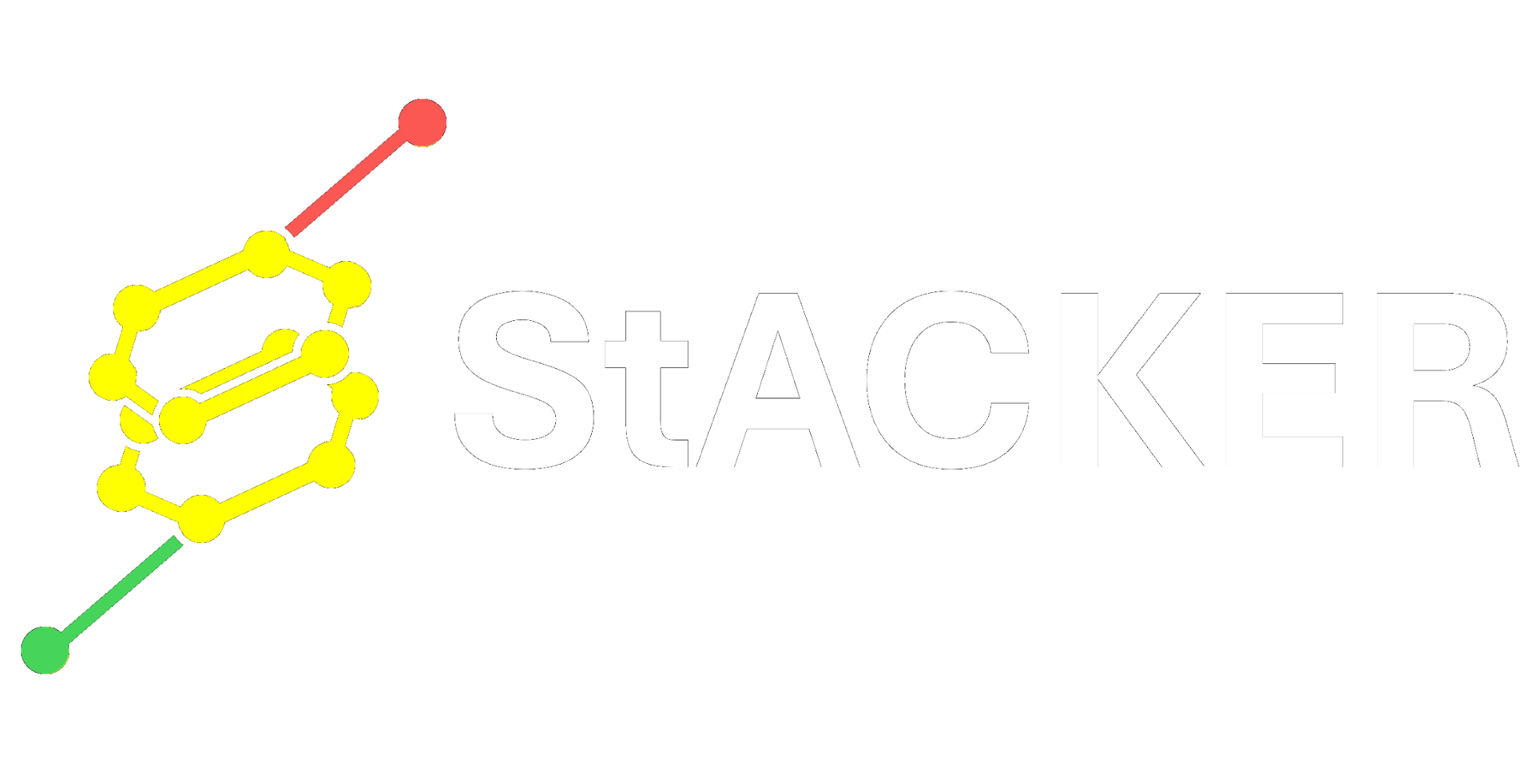Getting Started#
Welcome to getting started with StACKER!
StACKER (Stacking Analysis and Conformational Kinetics for Examining Residues) is an open source Python library for analyzing pi-stacking interactions between residues in Molecular Dynamics (MD) trajectories.
Installing StACKER#
StACKER can be installed through GitHub or through PyPi:
In the command line, run:
pip install pistacker
This will install StACKER, activate the command line option stacker,
and install all the necessary dependencies.
Alternatively, you can clone the GitHub repository to your local machine.
In the command line, run:
git clone https://github.com/esakkas24/stacker.git
Descend into the directory and download the neccessary dependencies:
cd stacker
pip install -r requirements.txt
pip install setuptools
python setup.py install
This will install StACKER, activate the command line option stacker,
and install all the necessary dependencies.
StACKER in the Command Line#
StACKER’s functions are available through a Python import and through
the Command Line. After installing StACKER, running stacker in the
command line will show the Command Line Options for StACKER:
[user]$ stacker
usage: stacker -s ROUTINE [-h]
Wrapper to run stacker subroutines using the -s flag.
More info on each routine given by `stacker -s ROUTINE -h` or `python stacker.py -s ROUTINE --help`
options:
-s ROUTINE, --script ROUTINE
Name of command to use. Options for ROUTINE:
filter_traj:
filters trajectory and topology files to desired residue numbers and atom names
bottaro OR pairwise OR psf:
Create a Pairwise Stacking Fingerprint (PSF): polar plots like those in Figure 1 of Bottaro et. al (https://doi.org/10.1093/nar/gku972)
res_distance:
Get the distance between two residues in a given frame
system OR ssf:
Create a System Stacking Fingerprint (SSF) with pairwise distances for each residue
stack_events:
Get list of residues with most stacking events (distance closest to 3.5Å)
compare:
Get the most changed stacking events between two fingerprints using the outputs of python stacker.py -s stack_events
-h, --help show this help message and exit
Read more about StACKER’s Command Line Options.
Importing StACKER to Python#
After installing StACKER, you can import it into Python code like:
import stacker as st
Although StACKER’s functions are further subsetted into modules,
all functions are accessible through st.________:
>>> st.<Tab>
st.AtomEmpty( st.create_axis_labels( st.os
st.Base( st.create_base_from_coords_list( st.pairwise_distance
st.FrameEmpty( st.create_parent_directories( st.pd
st.InvalidRoutine( st.csv st.plt
st.MultiFrameTraj( st.display_arrays_as_video( st.print_function
st.NoResidues( st.enable_printing() st.random
st.ResEmpty( st.file_convert( st.res_distance_routine()
st.SmartIndexingAction( st.file_manipulation st.residue_movement
st.Vector( st.filter_traj( st.run_python_command()
st.argparse st.filter_traj_routine() st.set_polar_grid()
st.block_printing() st.filter_traj_to_pdb( st.stack_events_routine()
st.bottaro_routine() st.get_frame_average( st.sys
st.calc_center_3pts( st.get_residue_distance_for_frame( st.system_routine()
st.calculate_bottaro_values_for_frame( st.get_residue_distance_for_trajectory( st.typing
st.calculate_residue_distance( st.get_top_stacking( st.vector
st.collect_atom_locations_by_frame( st.increment_residue( st.visualization
st.combine_frames( st.kdeplot( st.visualize_two_residue_movement_heatmap(
st.compare_routine() st.math st.visualize_two_residue_movement_scatterplot(
st.concurrent st.md st.write_bottaro_to_csv(
st.convert_to_python_command() st.mpl
3 more...
Read more about StACKER’s Python Options.
Reading the example code#
StACKER documents python examples like:
>>> import stacker as st
>>> st.increment_residue("G43")
'G44'
Text preceded by >>> or ... is input, the code that you would
enter in a script or at a Python prompt. Everything else is output, the
results of running your code. Note that >>> and ... are not part of the
code and may cause an error if entered at a Python prompt.
Molecular Dynamics (MD)#
Read a thorough overview of Molecular Dynamics
Currently, StACKER supports .mdcrd trajectory files, .prmtop topology
files, and .pdb files.
.mdcrd files are the standard trajectory output of the
AMBER MD Software Package. They are equivalent to
.trj files. Change the file extension to .mdcrd before inputting to StACKER.
.prmtop files are the Parameter-Topology file outputted by AMBER tLEaP.
.pdb files are a standard filetype for molecular structures (Cryo-EM, X-Ray Crystollography, etc.)
and include both trajectory and topology information. If an MD Software other than AMBER was used to
generate your MD Data, nearly all software support converting the trajectory to a PDB.
You can convert between these using filter_traj_to_pdb()
These can be imported into python using the mdtraj package, which is automatically
installed with StACKER.:
import mdtraj as md
md.load("traj.mdcrd", top = "top.prmtop")
Alternatively, the trajectories can be loaded in, pre-filtered using filter_traj()
